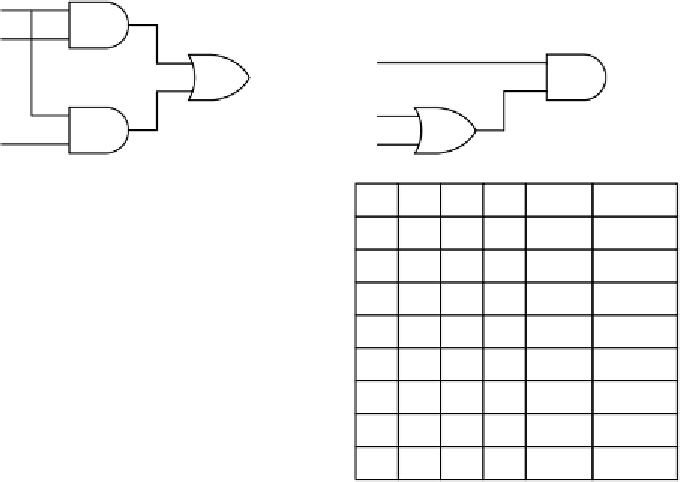Hardware Reference
In-Depth Information
A
B
AB
A
AB+AC
A(B + C)
B
AC
C
B+C
C
A
B
C
AB AC AB+AC
A
B
C
A B+C A(B+C)
0
0
0
0
0
0
0
0
0
0
0
0
0
0
1
0
0
0
0
0
1
0
1
0
0
1
0
0
0
0
0
1
0
0
1
0
0
1
1
0
0
0
0
1
1
0
1
0
1
0
0
0
0
0
1
0
0
1
0
0
1
0
1
0
1
1
1
0
1
1
1
1
1
1
0
1
0
1
1
1
0
1
1
1
1
1
1
1
1
1
1
1
1
1
1
1
(a)
(b)
Figure 3-5.
Two equivalent functions. (a)
AB
+
AC
. (b)
A
(
B
+
C
).
forms that are
duals
of each other. By interchanging AND and OR and also 0 and
1, either form can be produced from the other one. All the laws can be easily
proven by constructing their truth tables. Except for De Morgan's law, the absorp-
tion law, and the AND form of the distributive law, the results should be under-
standable with some st
udy.
De Mo
r
gan
'
s law can be extended to more than two
variables, for example,
ABC
C
.
De Morgan's law suggests an alternative notation. In Fig. 3-7(a) the AND
form is shown with negation indicated by inversion bubbles, both for input and out-
put. Thus, an
OR
gate with inverted inputs is equivalent to a
NAND
gate. From
Fig. 3-7(b), the dual form of De Morgan's law, it should be clear that a
NOR
gate
can be drawn as an
AND
gate with inverted inputs. By negating both forms of De
Morgan's law, we arrive at Fig. 3-7(c) and (d), which show equivalent repres-
entations of the
AND
and
OR
gates. Analogous symbols exist for the multiple-vari-
able forms of De Morgan's law (e.g., an
n
input
NAND
gate becomes an
OR
gate
with
n
inverted inputs).
Using the identities of Fig. 3-7 and the analogous ones for multi-input gates, it
is easy to convert the sum-of-products representation of a truth table to pure
NAND
or pure
NOR
form. As an example, consider the EXCLUSIVE OR function of
Fig. 3-8(a). The standard sum-of-products circuit is shown in Fig. 3-8(b). To
=
A
+
B
+




